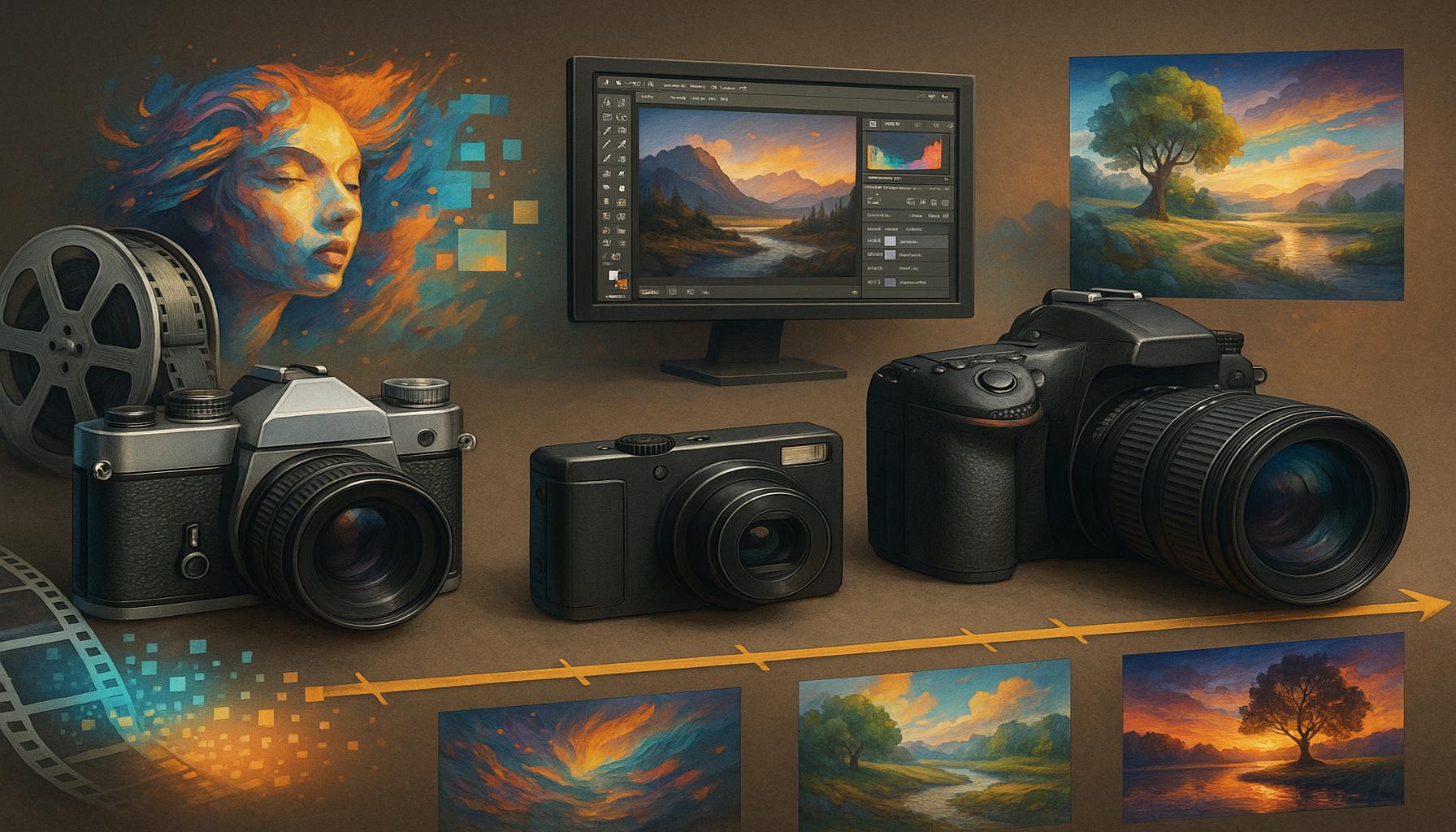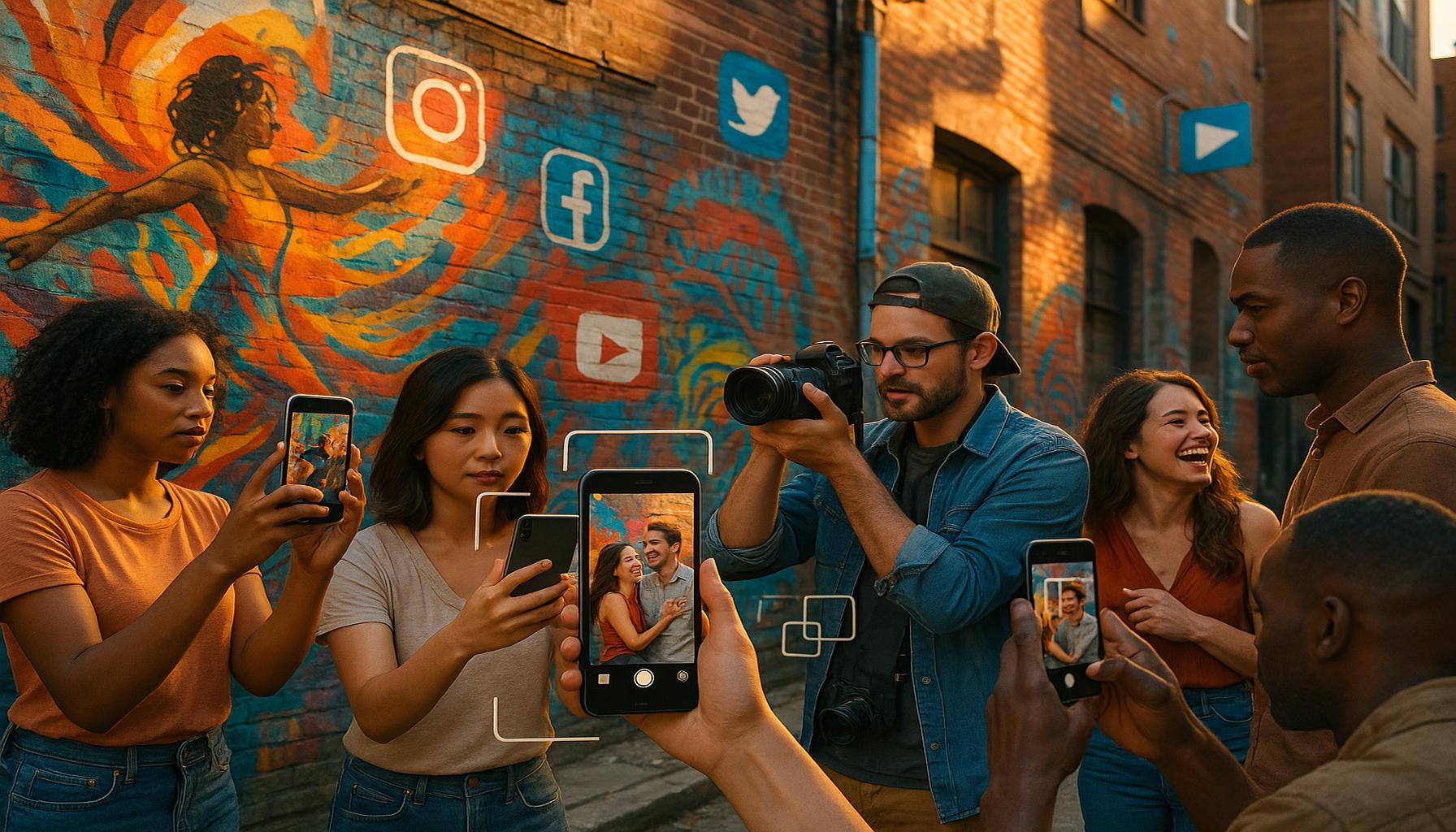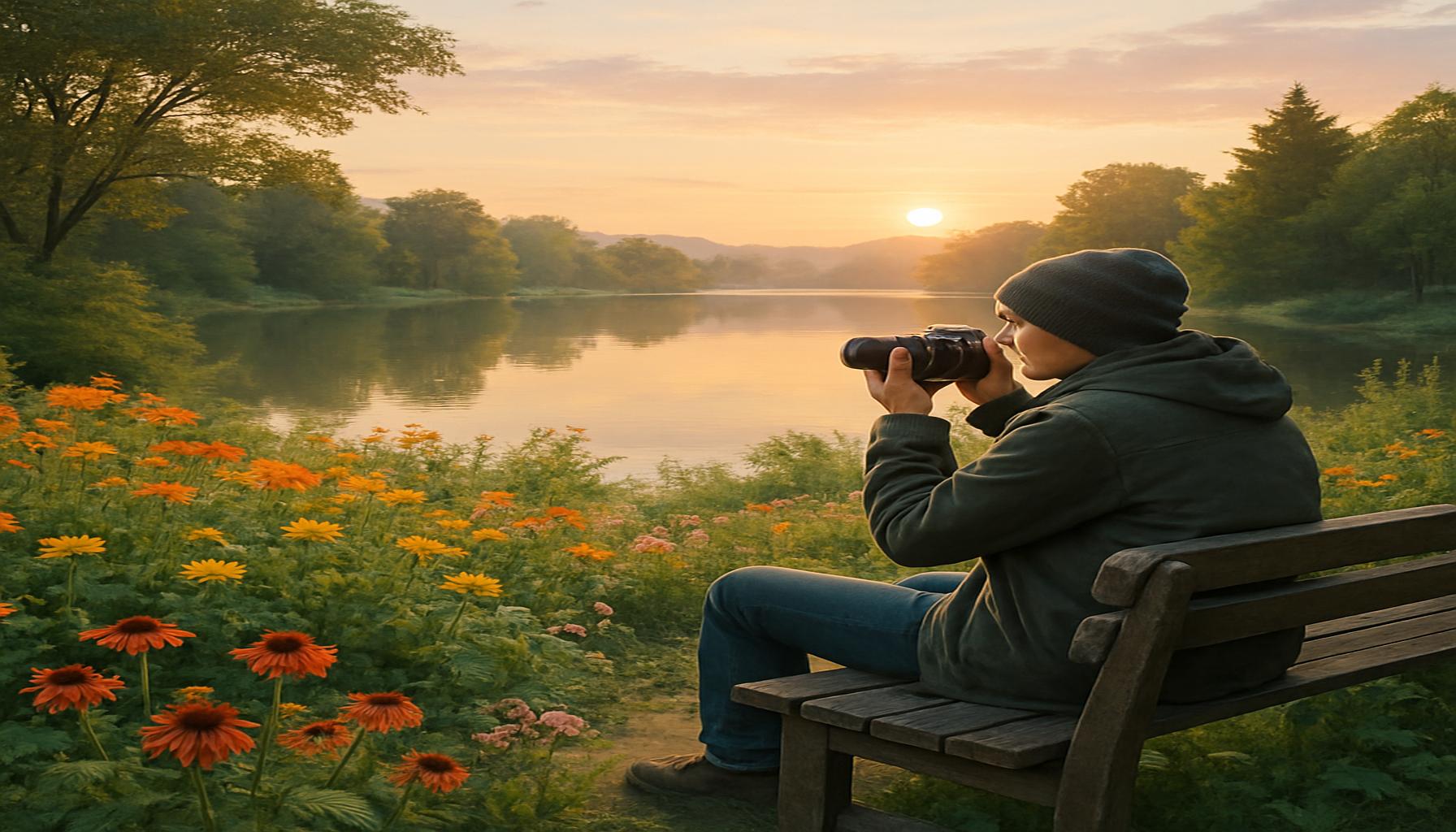The Evolution of Digital Photography and Its Impact on Personal Creativity

A Deep Dive into the Evolution of Visual Narratives
The landscape of photography has transformed dramatically over the years, paving the way for new forms of visual storytelling that resonate with diverse audiences. This evolution, largely fueled by digital technology, has not only influenced professional photographers but has also empowered everyday individuals to partake in the art of capturing moments.
Several key developments have played a significant role in this shift:
- Advancement of Camera Technology: The progression from bulky DSLRs to compact smartphone cameras has revolutionized the way people engage with photography. Modern smartphone models now boast advanced features, including multiple lenses, AI enhancements, and high-resolution capabilities, allowing even novice users to create stunning images comparable to those taken by professionals.
- Editing Software: The rise of sophisticated editing software such as Adobe Lightroom and user-friendly mobile applications like Snapseed has democratized the editing process. Users can effortlessly enhance colors, adjust lighting, and apply filters, transforming ordinary photographs into captivating visual narratives that echo their unique perspectives.
- Social Media Platforms: Platforms such as Instagram and Pinterest have revolutionized the dissemination of photographic art. These platforms have become virtual galleries, showcasing a plethora of styles and inspiring a community of creators. Photographers can garner feedback from a global audience, providing motivation and sparking new ideas while fostering a sense of connection with fellow artists.
As a consequence of these advancements, photography has transcended the boundaries of professional use. Today, with just a smartphone in hand, anyone can document life’s moments—from a family gathering at a local park to urban street photography capturing the essence of city life. This era of accessibility promotes a culture where creativity knows no bounds.
This democratization of photography encourages individuals to:
- Experiment with various photography styles, such as minimalism, street photography, or documentary styles, broadening their expressive capacity.
- Engage with communities, like local photography clubs or online forums, where aspiring photographers can share work, receive constructive critique, and find inspiration from others’ journeys.
- Cherish personal narratives through photography, enabling people to capture milestones, document travels, and weave their stories through visual art.
The profound impact of digital photography extends beyond the act of taking pictures. It pushes creative boundaries, inviting both casual photographers and experienced artists to explore their capabilities. In an age where everyone can narrate their story through the lens, the potential for innovation in visual storytelling is vast, fostering a dynamic and diverse artistic landscape.

DISCOVER MORE: Click here to learn about sustainable crafts
Revolutionizing the Captured Moment
To understand the impact of digital photography on personal creativity, it is essential to trace its roots back to the advent of digital image capturing technology. The transition from film to digital marked a paradigm shift in how images are taken and processed. Early digital cameras, which first gained popularity in the late 1990s, allowed photographers to take and review their photos instantly. This immediacy not only reduced the costs associated with film development but also encouraged spontaneous creativity. Photographers no longer had to worry about wasting film on underexposed or overexposed shots, leading to a whole new era of experimentation and exploration.
The introduction of digital sensors further enhanced image quality by capturing more light and detail, creating images that were sharper and more vibrant. Sensor technology has evolved dramatically over the last two decades, with innovations such as full-frame sensors and low-light capabilities becoming standard features in many consumer cameras. This improvement made it possible for amateurs to capture stunning landscapes or portraits in a variety of lighting conditions, broadening the horizons of personal creative expression.
Another significant milestone in this evolution has been the integration of smart technology into cameras. Modern digital cameras are now equipped with features like intelligent autofocus, face recognition, and scene optimization, making photography more user-friendly. Artificial Intelligence (AI) algorithms have pushed the envelope even further by simplifying complex tasks such as exposure adjustments and color correction. Every person armed with a smartphone can now produce breathtaking images with just a tap of a finger, encouraging users to engage more creatively with their environments.
As the tools for creating fantastic images have become more accessible, so too have the platforms for sharing them. The explosion of social media has rewritten the rules of engagement in photography. Users can now showcase their work on platforms such as Instagram and TikTok, gaining instant feedback and recognition. The visual-centric nature of these platforms promotes a community spirit among creatives, encouraging them to not only share their captures but also connect with like-minded individuals across the globe.
- Online Contests: With platforms encouraging user-generated content, many photographers have turned their passion into lucrative ventures, participating in contests that can elevate their work and careers.
- Learning Opportunities: Countless tutorials and resources are available online, allowing budding photographers to refine their skills through accessible education.
- Trending Styles: Trends emerge quickly, often influenced by viral content, enabling photographers to explore and adopt new styles or challenges, further enhancing their creative repertoire.
This convergence of technology and community has not only facilitated creative expression but also reshaped the way societies value and perceive photography. As more people engage with digital photography, personal creativity flourishes, embracing diversity in vision and style. The digital age has, therefore, created a landscape that inspires innovation and nurtures budding photographers, ensuring that the art of storytelling through images continues to thrive.
The Evolution of Digital Photography and Its Impact on Personal Creativity
The journey of digital photography has significantly reshaped how individuals express their creativity. With the transition from film to digital cameras, the barriers to capturing and sharing visual stories have drastically decreased. Today, individuals are not just passive viewers but active creators. The simplicity and accessibility of digital photography empower enthusiasts of all skill levels to explore and develop their artistic vision.
Digital photography has also introduced an array of innovative technologies that enhance personal creativity. Advanced editing software and an abundance of apps allow creators to manipulate images in ways previously unimaginable. Techniques such as HDR imaging and digital collage offer creative freedom, making it easier than ever to push the boundaries of traditional photography.
Moreover, the social media revolution provides a platform where creators can showcase their work, receive feedback, and connect with a global audience. This instant gratification and connectivity nurture a culture of learning and collaboration among aspiring photographers. Online communities and social networks have thus become a valuable resource for sharing tips, tricks, and inspiration, further fueling the creative impulses of individuals.
As technology continues to evolve, the impact on personal creativity is profound. The rise of high-quality smartphone cameras exemplifies this transformation. They have democratized photography, allowing anyone to capture stunning images readily. This conveniently portable equipment fosters spontaneous moments of creativity, encouraging individuals to see the world through an artistic lens, no matter the situation.
In essence, digital photography is not just a medium; it is a catalyst for personal expression and creativity. It encourages individuals to explore new ideas, experiment with different styles, and ultimately find their unique voice within the artistic landscape.
| Category | Advantages |
|---|---|
| Accessibility | Digital photography allows anyone with a smartphone or camera to create and share art easily. |
| Innovative Tools | A variety of editing software and apps facilitate creative expression, enabling users to enhance their work. |
As we delve deeper into the nuances of digital photography, it becomes clear that its evolution is not just about technology; it profoundly impacts the very essence of personal creativity.
DIVE DEEPER: Click here to unlock your imagination
The Democratization of Photography
The evolution of digital photography has not only revolutionized the technical aspects of capturing images but has also democratized the art of photography, making it accessible to everyone, regardless of skill level or resources. The smartphone explosion in the 2010s further accelerated this trend, as nearly everyone became a potential photographer with a high-quality camera in their pockets. According to the Pew Research Center, over 85% of American adults now own smartphones, enabling widespread participation in a culture once restricted to those with professional equipment and training.
This widespread accessibility has led to the rise of a new breed of photographers known as social media influencers. Influencers leverage their photography skills to build brands, cultivate audiences, and engage with followers, blending personal creativity with entrepreneurial spirit. These influencers, many of whom began as everyday individuals passionate about photography, demonstrate how digital photography can provide not only a creative outlet but also new career pathways. The viral nature of online platforms facilitates rapid exposure, allowing unique styles and perspectives to gain traction and, in many cases, leading to lucrative opportunities.
Moreover, the evolution of editing software has further empowered photographers at all levels, enabling them to manipulate their images in ways previously reserved for professional studios. Tools like Adobe Lightroom and Photoshop have become household names, transforming how users approach their creative processes. With the availability of mobile apps such as Snapseed and VSCO, users can apply sophisticated filters, make corrections, and experiment with artistic effects right from their phones. This democratization of editing technology allows novices to refine their photographs, encouraging experimentation and the creation of distinct personal styles. Consequently, the line between amateur and professional photography continues to blur.
The empowered role of the photographer has fostered a shift in the visual culture, ushering in a new era of storytelling. Today, people use photography not only to capture scenic beauty but also to convey messages about social issues, personal narratives, and cultural identity. The ability to create and share high-quality images has transformed photography into a medium for advocacy and expression. For example, movements such as Black Lives Matter have utilized social media platforms to spotlight injustices through powerful visual storytelling, proving that photography can be a catalyst for change.
- Cultural Exchange: As digital photography enables global sharing, diverse cultural perspectives emerge, enriching the visual narratives presented online.
- Virtual Communities: Online photography clubs and forums allow enthusiasts to share feedback, engage in collaborative projects, and learn from one another, fostering a sense of camaraderie.
- Innovative Trends: Emerging genres like drone photography and 360-degree photography excite photographers to explore new techniques, expanding the boundaries of what is visually possible.
This interconnectedness and collaboration among photographers is crucial in cultivating a vibrant ecosystem of creativity. As technology continues to advance, personal creativity is invigorated, encouraging individuals to push the envelope and redefine what photography can achieve in an ever-evolving digital landscape. The continuous growth of digital photography serves not only as a tool for expression but also as a platform for personal and collective narratives—ultimately enriching the cultural tapestry of society.
DISCOVER MORE: Click here to dive into the art of storytelling
Conclusion: The Future of Personal Creativity in Digital Photography
The journey of digital photography has profoundly reshaped how we engage with visual expression, fostering innovation and accessibility like never before. By transitioning from film to pixels, the democratization of photography has emerged, enabling individuals from all walks of life to experiment creatively, document their experiences, and share personal narratives. The proliferation of smartphones and editing apps has not only enhanced our technical capabilities but has also encouraged a generation of aspiring photographers to break conventional barriers and redefine the artistic landscape.
As we reflect on the impact of digital photography on personal creativity, it becomes clear that the medium has transcended traditional perceptions of art. It has evolved into a powerful vessel for storytelling and social engagement, proving instrumental in movements that seek to spark societal change. With tools that empower both professionals and amateurs alike, the lines between these roles have become increasingly blurred, resulting in a diverse community that continually influences and inspires.
Looking ahead, the future of digital photography promises even greater innovations—such as artificial intelligence in image manipulation and immersive technologies like virtual reality—paving the way for uncharted creative territories. As photography continues to morph in response to technological advancements, one can envision an era where personal creativity is boundless. In this landscape, every image captured could become a vital part of collective memory, inspiring new dialogues and fostering a richer understanding of the diverse human experience.
Ultimately, the evolution of digital photography and its impact on personal creativity embodies a dynamic interplay of technology, culture, and community. Embracing this evolution invites everyone to explore their unique perspectives and contribute to the vibrant tapestry of visual storytelling that shapes our modern world.



